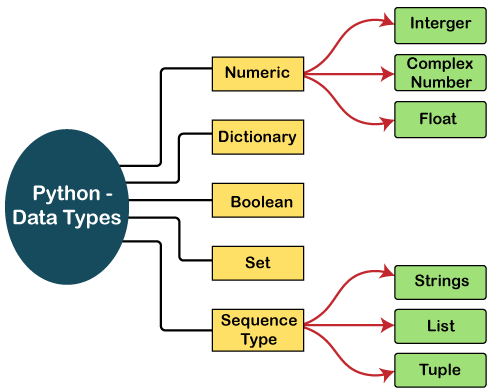Python Tutorial
Python OOPs
Python MySQL
Python MongoDB
Python SQLite
Python Questions
Plotly
Python Tkinter (GUI)
Python Web Blocker
Python MCQ
Related Tutorials
Python Programs
Python Data TypesEvery value has a datatype, and variables can hold values. Python is a powerfully composed language; consequently, we don't have to characterize the sort of variable while announcing it. The interpreter binds the value implicitly to its type. We did not specify the type of the variable a, which has the value five from an integer. The Python interpreter will automatically interpret the variable as an integer. We can verify the type of the program-used variable thanks to Python. The type() function in Python returns the type of the passed variable. Consider the following illustration when defining and verifying the values of various data types. Output: <type 'int'> <type 'str'> <type 'float'> Standard data typesA variable can contain a variety of values. On the other hand, a person's id must be stored as an integer, while their name must be stored as a string. The storage method for each of the standard data types that Python provides is specified by Python. The following is a list of the Python-defined data types. 
The data types will be briefly discussed in this tutorial section. We will talk about every single one of them exhaustively later in this instructional exercise. NumbersNumeric values are stored in numbers. The whole number, float, and complex qualities have a place with a Python Numbers datatype. Python offers the type() function to determine a variable's data type. The instance () capability is utilized to check whether an item has a place with a specific class. When a number is assigned to a variable, Python generates Number objects. For instance, Output: The type of a <class 'int'> The type of b <class 'float'> The type of c <class 'complex'> c is complex number: True Python supports three kinds of numerical data.
Sequence TypeStringThe sequence of characters in the quotation marks can be used to describe the string. A string can be defined in Python using single, double, or triple quotes. String dealing with Python is a direct undertaking since Python gives worked-in capabilities and administrators to perform tasks in the string. When dealing with strings, the operation "hello"+" python" returns "hello python," and the operator + is used to combine two strings. Because the operation "Python" *2 returns "Python," the operator * is referred to as a repetition operator. The Python string is demonstrated in the following example. Example - 1 Output: string using double quotes A multiline string Look at the following illustration of string handling. Example - 2 Output: he o hello javatpointhello javatpoint hello javatpoint how are you ListLists in Python are like arrays in C, but lists can contain data of different types. The things put away in the rundown are isolated with a comma (,) and encased inside square sections []. To gain access to the list's data, we can use slice [:] operators. Like how they worked with strings, the list is handled by the concatenation operator (+) and the repetition operator (*). Look at the following example. Example: Output: [1, 'hi', 'Python', 2] [2] [1, 'hi'] [1, 'hi', 'Python', 2, 1, 'hi', 'Python', 2] [1, 'hi', 'Python', 2, 1, 'hi', 'Python', 2, 1, 'hi', 'Python', 2] TupleIn many ways, a tuple is like a list. Tuples, like lists, also contain a collection of items from various data types. A parenthetical space () separates the tuple's components from one another. Because we cannot alter the size or value of the items in a tuple, it is a read-only data structure. Let's look at a straightforward tuple in action. Example: Output: <class 'tuple'>
('hi', 'Python', 2)
('Python', 2)
('hi',)
('hi', 'Python', 2, 'hi', 'Python', 2)
('hi', 'Python', 2, 'hi', 'Python', 2, 'hi', 'Python', 2)
Traceback (most recent call last):
File "main.py", line 14, in <module>
t[2] = "hi";
TypeError: 'tuple' object does not support item assignment
DictionaryA dictionary is a key-value pair set arranged in any order. It stores a specific value for each key, like an associative array or a hash table. Value is any Python object, while the key can hold any primitive data type. The comma (,) and the curly braces are used to separate the items in the dictionary. Look at the following example. Output: 1st name is Jimmy
2nd name is mike
{1: 'Jimmy', 2: 'Alex', 3: 'john', 4: 'mike'}
dict_keys([1, 2, 3, 4])
dict_values(['Jimmy', 'Alex', 'john', 'mike'])
BooleanTrue and False are the two default values for the Boolean type. These qualities are utilized to decide the given assertion valid or misleading. The class book indicates this. False can be represented by the 0 or the letter "F," while true can be represented by any value that is not zero. Look at the following example. Output: <class 'bool'> <class 'bool'> NameError: name 'false' is not defined SetThe data type's unordered collection is Python Set. It is iterable, mutable(can change after creation), and has remarkable components. The elements of a set have no set order; It might return the element's altered sequence. Either a sequence of elements is passed through the curly braces and separated by a comma to create the set or the built-in function set() is used to create the set. It can contain different kinds of values. Look at the following example. Output: {3, 'Python', 'James', 2}
{'Python', 'James', 3, 2, 10}
{'Python', 'James', 3, 10}
Next TopicPython Keywords
|
 For Videos Join Our Youtube Channel: Join Now
For Videos Join Our Youtube Channel: Join Now
Feedback
- Send your Feedback to [email protected]
Help Others, Please Share










